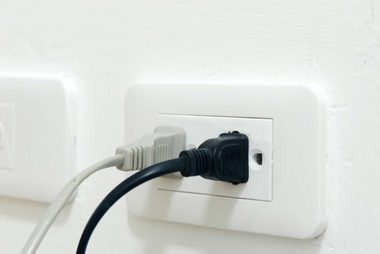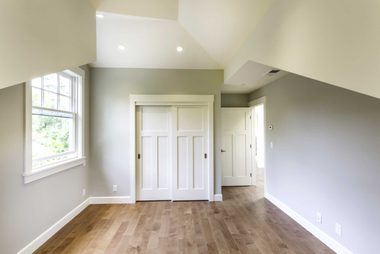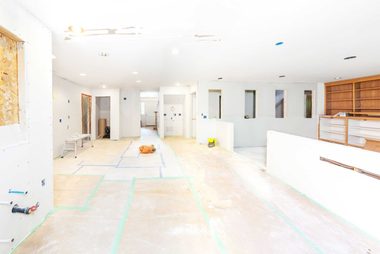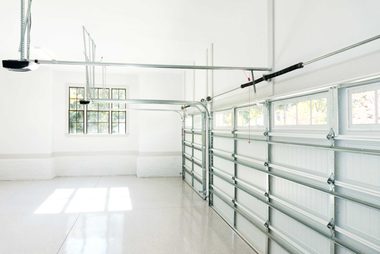
Permits can take time
As a prospective home buyer, it’s easy to get carried away with visions of grandeur. Home renovation projects like a new patio, garage, or addition involves permits first and the process could be as quick as a few days or weeks, depending on the project and your city’s specifications. “A new deck or patio, for instance, can take months if conservation and board hearings are required,” says Tom Sullivan Owner, T.M. Sullivan Construction. “Until you sign on the dotted line and the keys are in your hand, you as the homeowner, cannot pull a permit.” That means you have to close on the purchase of your home before you can even start with the paperwork, which can take weeks. Here are more secrets your real estate agent isn’t telling you.

Manage your expectations
“Schedules are very important as well and need to be looked at from all angles. The first thing most new homeowners want is to sign on the dotted line, get their keys, and start moving in,” says Sullivan. Although it’s possible to move in right away, that’s not always the case. The house may not be livable until certain projects are complete. Sullivan likens this to having a shiny new car in the driveway, but not being able to drive it for a few weeks or even months. “As a contractor, my goal is to give my clients a realistic time frame that they can plan on and if anything unforeseen arises, I do my best to address it quickly and properly,” says Sullivan. Here are more packing hacks to make your next move as stress-free as possible.

Get an estimate first
Bumping out a couple of walls to create an open floor plan may not seem like a big deal. It’s just removing two walls, right? “Budgets are always an important component of any project, no matter the size or scope of the project,” says Sullivan. “Enlisting the help of a contractor as early as possible is the best approach. The process works best when the contractor can see the proposed project and get ballpark figures together for the homeowner before the contract is drawn up for the home.” You may experience sticker shock and find you don’t have enough cash to make it into your dream home if you wait to get an estimate after closing on the house. Here are 15 more questions every homebuyer should ask.

Installing central air
You fell in the love with the old world charm of a 1800s Victorian, but there’s no air conditioning. Now, you’re wondering how you’re going to beat the heat in this old painted lady without putting a freeze on your budget. Sullivan says there are some factors to consider. “Adding central air to a home can be as simple as adding a condenser and tying into the existing forced hot air system, or can be as complicated as adding chases/soffits to conceal duct work. If your new home has forced hot air for heat it is a relatively easy solution. If your new home has forced hot water baseboard, steam, or electric baseboard, it’s a little more complicated,” notes Sullivan. An option for historic homes where running duct work isn’t possible are to use ductless, or mini split, units which use a condenser outside and a small wall hung unit inside. You’ll want to factor in other components when adding central air. “A homeowner will most likely need more than an HVAC company. This home renovation project will also need an electrician at a minimum, but it will also involve some wall repair and painting. Be sure to keep these things in mind as they can really add to your budget,” says Sullivan. You need to know these air-conditioning tricks to save money, too.

If walls could talk
According to Anthony M. Gisondi, contractor and founder of Noreast Property Management, prior to the 1960s the majority of homes were built using lath and plaster to create a smooth finish on interior walls and ceilings. “Although beautiful, plaster walls also come with some hidden costs. Repairing plaster walls can be very costly due to their age and the increased complexity of the needed repairs over that of sheetrock. This is something to keep in mind if you have plans to do some energy-saving upgrades that involve new wiring for outlets or running lines in the ceiling for recessed or overhead lighting. “The increased costs to make these upgrades in a home with plaster walls and ceilings will be significantly greater than making the same upgrades in a home that is built with sheetrock walls and ceilings, says Gisondi. Learn more surprising costs every homebuyer should know about.

Moving walls
If you’re a fan of home renovation and improvement shows, you know that almost every episode involves remodeling by moving or knocking down walls to get that all important “open floor plan.” It seems like a viable solution in any home but it might not be for the house you want to buy. “Every building is designed differently so if it’s a clear-span truss design that means you can take the interior walls out and move them around without structural impact as they are considered architectural partitions,” says John A. Salat A.I.A. Licensed Architect owner of Zen Architect. However, you’ll need an expert to verity that or you. “The cost for structural retrofitting can range from $1,000 to $10,000.”

Where’s the dirt?
The gingerbread trim of the old Victorian may grab your attention more than the dirt around the house, but it’s important you take a closer look. “Proper drainage is the single most important feature to look for in older homes, because poor drainage causes the most expensive repairs,” says Chris Dolan, general contractor and President of House. “Look for houses where the dirt around the house falls away from the house, creating “positive” drainage away from the house.” Dolan suggests steering clear from homes with a steep slope or eroded properties. This issue or homes that have the ground or grade being pushed up against the house could mean costly repairs. “Foundations can crack, columns that hold up porches and decks can move and sink, basement floors can swell and sink and retaining walls can fall down,” says Dolan.

Unfinished additions
You might get lucky and find a house with some improvements already in the works, like an addition for a future family room. Even if the concrete has been poured and the walls are framed, it doesn’t necessarily mean it will be an easy on the budget to finish. “Consult a general contractor to make verify that the framing is up to code, there is proper drainage and if the foundation is deep enough and sized properly,” recommends Dolan.

Know your roots
The giant oak trees immediately won you over. Better check your roots first. “If large trees with aggressive root systems are planted too close to the house or underground pipes, their root systems can definitely damage the pipes or foundation in the same way that you see roots breaking up concrete sidewalks all the time,” cautions Nate Mason, ISA Certified Arborist at Monster Tree Service. “Trees that have not been properly maintained present two issues for houses. First, large limbs or whole trees over houses which are structurally unstable can fail in a storm, falling on the house and causing property damage. Second, tree limbs or shrubbery that is growing up against the siding or roof of the house, creating a moist, shady environment which leads to the growth of mold, moss, and mildew which can damage the siding, as well as causing property damage,” says Mason.

Can you plug it in?
The garage is begging to be a man cave, complete with a kegger fridge but can you plug it in without blowing a fuse and your budget? Before you make a move on the house, think about all appliances and upgrades, like a sprinkler systems that may be more taxing on the current 100 amp service. If the house is older, it may need electrical upgrades. “The house might need electrical upgrades. Check all switches and receptacles to make sure they are wired correctly and up to code. GFCI’s, or “ground fault circuit interrupters,” are located in the kitchen, bathrooms, outside on porches and in garages. These are the outlets in which one can reset with a push button,” says Joel Worthington, President of Mr. Electric. Don’t forget to check the outside outlets. They should have weatherproof covers on them. “Potential dedicated circuit, surge protection at the panel and grounding are also crucial, especially for older homes. Most people don’t realize these are necessities,” says Worthington.

Home inspections are worth the money
Even if the house is brand new or you’re buying it from your buddy who is a realtor, a home inspection is an essential part of buying a house. “It may add $400 to $500 to the cost of the process, but it’s better to know any problems ahead of time rather than discovering you’ve purchased a money pit,” says 2017 NAHB Remodelers Chair, Dan Bawden, CAPS, of the National Association of Home Builders. “If issues do arise during the inspection, electrical issues are the top priority to repair as old breaker boxes and incorrect home-owner wiring from the past can burn your house down. Plumbing concerns are next, followed by foundation problems.” Check out the secrets home inspectors won’t tell you.